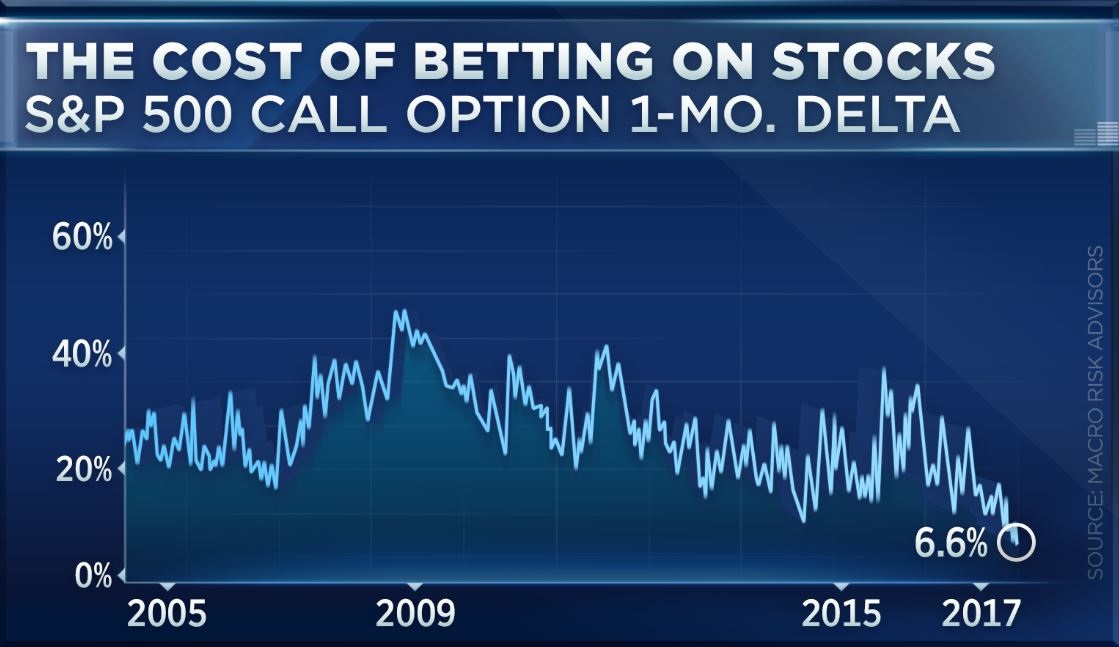If you think the S&P 500 is set to rise even higher from current, near-record levels, you’re in luck. Bullish options contracts that will increase in value should the market rise a few percentage points over the course of the next month have rarely cost less.
“They’re basically giving away call options,” Pravit Chintawongvanich, head of derivatives strategy at Macro Risk Advisors, surmised Monday on CNBC’s “Trading Nation.”
To be sure, options are exceedingly cheap across the board. The market’s lack of movement has encouraged people to pay less and less for financial products that derive a large share of their value from the market’s propensity to either rise or fall.
This can plainly be seen in a chart of the CBOE Volatility Index, or the VIX, which uses options prices to gauge how volatile the S&P 500 is expected to be. This month, the VIX has been plumbing multidecade lows.
Within this broader climate, Chintawongvanich looked specifically at call options that will generate value should the S&P rise by more than 2.5 percent in one month’s time. As a reminder, since the purchaser of a call receives the right, but not the obligation, to buy an asset for a certain price within a given time frame, the calls offer a fixed amount of risk.
These days, that risk has been fixed at a low level indeed. To take a specific example, S&P call options with a striking price of 2,520 and which expire a month from Tuesday are currently trading for just $1.30. In simple language, one can be exposed to all of the S&P 500’s potential returns above the 2,520 level for just 0.05 percent of the value of the index.
If the index rises by 5.1 percent in the next month, as it did from Feb. 1 to March 1, that $1.30 will turn into $63.15. If the index remains flat or falls, that $1.30 will turn into $0.
This is what options traders would call an “asymmetric risk-reward profile,” and it is nothing new. But what is noteworthy is just how little those call options buyers are being asked to risk.

Specifically, Chintawongvanich found that these options are trading as if the chance of the S&P rising by 2.5 percent in the next month is just 6.6 percent.
“That probability is near its lowest levels in over a decade,” the options strategist wrote in a Monday note to clients, adding: “That seems a little ridiculous. Sure, volatility is low, but it’s not that low!”
When actual S&P 500 volatility over the prior month has been at these current, relatively low levels, the S&P 500 has still risen by more than 2.5 percent in 28 percent of instances. Given the stark difference between this number and the 6.6 percent chance of such a rally implied by options prices, it is easy to see why Chintawongvanich proclaims such call options “very cheap.”
For those who want to take advantage of such apparent value, he recommends buying August-expiring call options on the S&P 500 ETF (SPY) with a striking price of $250. On Tuesday, these can be purchased for 40 cents per share, or $40 per options contract (since each contract controls 100 shares).
Such a purchase may make for an interesting contrarian trade, as Evercore ISI technical analyst Rich Ross pointed out Monday.
“Usually on Wall Street, when we ascribe a de minimis probability of something happening, there’s actually a much greater chance of that thing happening,” Ross said on “Trading Nation.” “So the fact that they’re virtually ‘giving away’ these call options, to use [Chintawongvanich’s] words, tells us that maybe it’s something that I want in this case.”
To be sure, while he might want inexpensive call options, Ross does think the market appears to have a greater chance of falling than rising in the short term, due to the “extreme weekly overbought conditions” he sees in the charts.
Source: Investment Cnbc
A striking stat shows why even the bears are tempted to bet on stocks